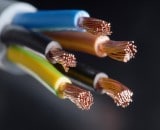
Published: October 2020
The British Standard on requirements and test methods for a popular class of PVC-insulated electric cable has now been amended to reflect developments in cable manufacture. This blog post describes what the standard does and how the amendment came about.
BS 6004:2012+A1:2020 Electric cables – PVC insulated and PVC sheathed cables for voltages up to and including 300/500 V, for electric power and lighting is a British Standard that specifies essential constructional parameters, test procedures and performance criteria for a range of widely used PVC insulated and sheathed energy cables. These are intended for general use for lighting and power circuits, and include types suitable for use at low ambient temperatures.
The standard deals with cables that have a polyvinyl chloride (PVC) insulation of rated voltage 300/500 V and are intended for electric power and lighting. The types of cable included in the standard are PVC insulated, PVC sheathed cable 300/500 V, single-core 6181Y, flat-twin 6192Y and 3-core 6193Y; PVC insulated, PVC sheathed cable with circuit protective conductor, 300/500 V, single-core 6241Y, flat-twin 6242Y and 3-core 6243Y; PVC insulated, PVC sheathed cable with or without circuit protective conductor, 300/500 V, single-core 6192Y, 6241Y and flat-twin 6242Y (alternative conductor versions); or ordinary duty low temperature PVC insulated, PVC sheathed flexible cable, 300/500 V, flat-twin 3192A, circular-twin 3182A, 3-core 3183A, 4-core 3184A and 5-core 3185A.
The insulation and other components are suitable to permit operation of the cables at a maximum sustained conductor temperature of 70 °C and for a maximum short-circuit conductor temperature of 160 °C (for a maximum period of 5 s).
Regularly revised
This standard first saw the light of day way back in 1984, since when it has been regularly revised to keep pace with changing technology. The last full revision was undertaken in 2012. It happened in response to CENELEC’s conversion of Harmonization Documents HD 21 and HD 22 to BS EN 50525 (all parts). The previous edition of BS 6004 had included a number of cable types that were harmonized and marked with CENELEC harmonized code designations. Specific types of cable were included in BS EN 50525 and therefore withdrawn from BS 6004, which now only contains national types.
BS 6004 now consists of 16 sections and six annexes. Following on from the scope, normative references and terms and definitions, it specifies rated voltage, construction, and conductors, before tackling the insulation system, identification of cores, multi-core circular cables and the sheath. This includes type of sheath, application, thickness and colour.
The standard then moves on to specify cable marking and additional information, schedule of tests, test conditions, routine tests, sample tests and finally test types.
The annexes give information on coding cross references, a list of the traditional UK cables transferred to BS EN 505025 (both those formerly in BS 6004 and formerly in BS 6500). There’s also an annex giving guidance on use; one on compatibility testing; one on method of test for voltage withstand; and a final annex giving notes on types tests.
The 2020 amendment
The basis of the 2020 amendment is that since the 2012 revision, manufacturing techniques have developed significantly. They now enable multi-material insulation and sheathing systems to be used in the manufacture of PVC cables.
The standard has therefore been amended to reflect this development. As a result the latest version of BS 6004 includes important changes. For example, the amended standard includes new requirements on the application of the insulation system and the sheath, and a new spark test.
At the same time we also took the opportunity to include additional small updates that reflect other changes to current industry practice. These have made changes to constructional materials and testing procedures. All told, this latest amendment thus brings the standard up to date with what the manufacturers and testers of this type of electric cable need now.